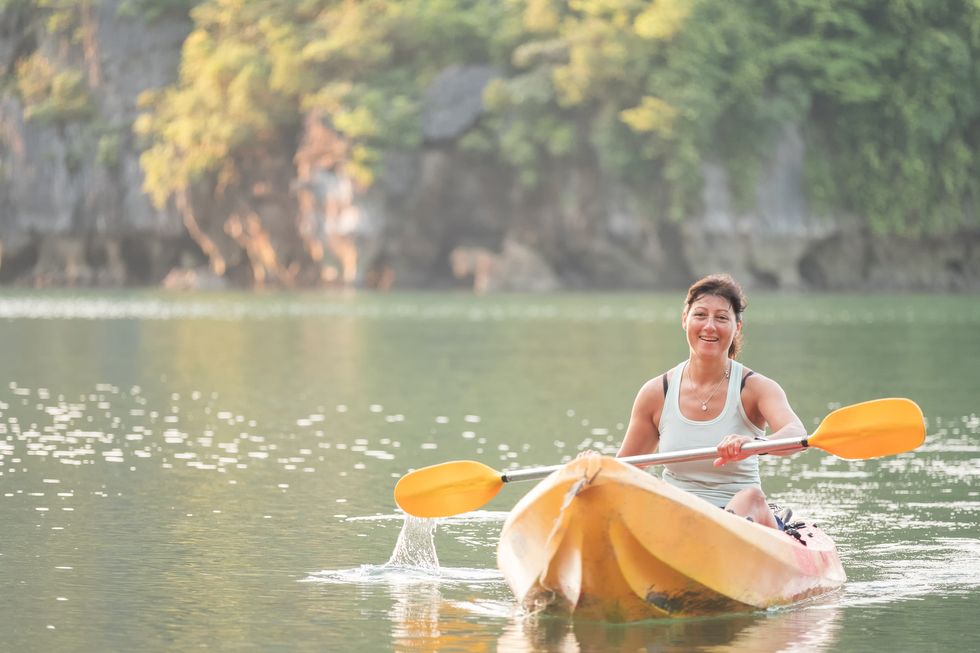You may love the mental high and well-being boost you get from your outdoor activities. But certain ones offer more benefits than others.
A survey for the independent research project Women in Adventure was done from October 2017 to January 2018. It interviewed 2,700 women mostly ages 18 to 65 were from 44 countries who participate in adventure sports. They were asked how they spend their time outside and how it impacts four areas of their mental well-being—happiness, worthwhileness, life satisfaction and anxiety.
Findings revealed that 90 percent find the outdoors has a positive impact on their mental well-being. The survey also looked at the effect of specific outdoor activities. It focused on 11 popular adventure sports—hiking, cycling, running, wild camping, swimming, climbing, kayaking, mountaineering, canoeing, skiing and surfing.
Kayakers were the most satisfied with life, followed by canoeists and then skiers. Surfers had the lowest life satisfaction. Skiers were happiest by a large margin, followed by kayakers. Climbers were least happy with life. Skiers and kayakers felt the most worthwhile and surfers the least worthwhile. Surfers had the lowest anxiety and climbers had the highest.
So now maybe you might want to try kayaking and skiing which offer major mental health benefits. Find out more about these sports.
What to know about kayaking
Here are a few tips if you're headed into the water for the first time.
- Hold the paddle correctly. Use two hands, shoulder-length apart with an overhand grip on the paddle shaft. Use an angled dip with the blade just beneath the surface.
- Know the water temperature. If the water is cold (even if the air is warm), you'll want to wear a wetsuit if you end up in the water.
- Stay close to shore and avoid choppy waters and rapids your first time out.
- Choose the right kayak. A recreational one will be suitable for most beginners. Once in the kayak, adjust the seat and foot pegs to what's comfortable for you.
- Get a dry storage bag. It can protect your phone, keys, wallet and any other essentials. You can also throw in a hat, sunglasses and sunscreen since water amplifies the sun's strength.
- Wear bright clothing. A kayaker sits low on the water. That makes it difficult for larger boats to see you. Bright clothing, especially if you're on waters with motorized boats, can promote visibility.
- Put on a life jacket. It could help save your life. And be sure to wear it. It won't do any good if it's not on you.
- Paddle with a partner. It's more fun and safer, too. A fellow kayaker can help you if you lose a paddle, for example.
- Don't drink and paddle. It will only impair your reaction times.
What to know about skiing
Find out a few beginner's tips before you hit the slopes.
- Protect your skin. The sun reflects off the snow. Wear lip balm and sunscreen on your face. Put on googles or ski sunglasses to protect your eyes.
- You will fall over. Don't be afraid or discouraged.
- A helmet is essential. Don't hit the slopes without one.
- The right ski boots should feel tight but not unbearable. You should be able to wiggle your toes.
- Learning how to stop should be the first skiing skill you master. Once you can start and stop safely, you won't endanger yourself or others.
- Control your skis. Don't let them control you. Lean forward when you're going downhill; it will give you more control over your skis.
- If hitting the slopes with friends or family, arrive early. That way you can sort your equipment and get comfortable.
- Don't go to fast. Take your time and go at your own pace. Increase your speed over time. Going too fast also prevents you from concentrating on proper technique, which is important if you plan to continue with the sport.
- Don't overextend yourself. If you push yourself too hard, you may get seriously injured.







